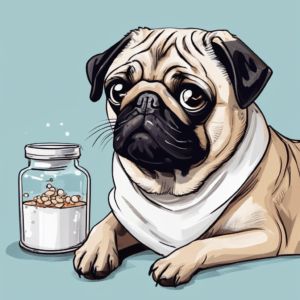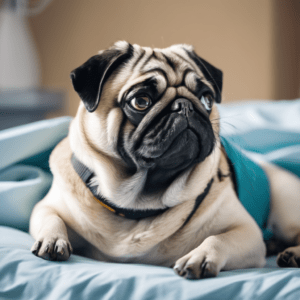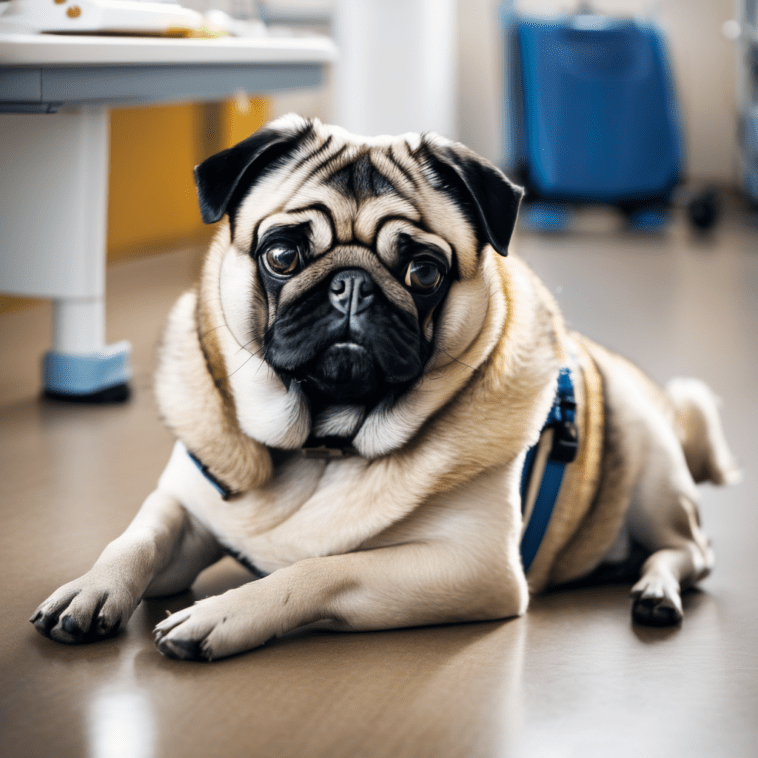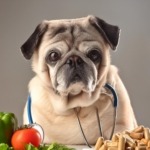Last updated on September 27th, 2024
Here’s an overview:
Understanding Pug Obesity: The Risks and Consequences
The Pug Diet: What to Feed Your Pug for Optimal Weight
How much and how often should your Pug eat?
Balancing Rewards and Caloric Intake: The Role of Treats
Hydration and Weight Management in Pugs
Keeping Active for Weight Loss: Exercise Essentials for Your Pug
Why Regular Vet Check-Ups Are Important For Monitoring Weight Gain And Loss
Weight Problems in Pugs: How to Spot Them
Making a Personalized Weight Loss Plan for Your Dog
Celebrating Success: How to Stay Motivated with Your Pug’s Weight Loss Journey
Can Supplements and Special Diets Help My Pug Lose Weight?
Understanding Pug Obesity: The Risks and Consequences
Here we tell about what risks are connected with the Pug Obesity and understanding of them.
- Joint Problems: Extra pounds may cause joint pains by putting pressure on them.
- Respiratory Distress: Breathing difficulties might get worse due to extra weight which presses upon airways.
- Diabetes: Overweighing increases riskiness in contracting this illness because bodies become less sensitive towards produced insulin thus needing more efforts when it comes to controlling levels.
This awareness can be a good starting point for pug owners who want to help their pets lose weight and live healthier lives.
The Pug Diet: What to Feed Your Pug for Optimal Weight
Here’s what should be considered:
What kinds of foods will keep my dog at its best?
- High-Quality Dog Food: Choose premium brands made specifically for small breeds so that all necessary nutrients get provided
- Controlled Portions: Give several small meals throughout the day instead of one big meal, this helps avoid overeating and promotes weight control
- Lean Proteins: Chicken or turkey meat without skin are recommended as they provide necessary muscle building blocks without adding too many calories
- Complex Carbohydrates: Foods high in fiber, like sweet potatoes which contain fiber aiding digestion process and making pugs feel full longer periods between meals
- Healthy Fats: Found in fish oil or flaxseed oil can improve coat condition while acting as appetite suppressant due to their slow digestion rate thus reducing calorie intake from treats
- Limited Treats: No more than ten percent (10%) should come out off daily caloric needs lest excessive weight gain occur; also make sure only healthy snacks given such as carrot sticks rather than high sugar content biscuits which would lead into obesity problems if consumed frequently over extended time frames without breaks!
- Fresh Water: Make sure there is always clean drinking water available since it helps with metabolism thereby preventing dehydration-related disorders like kidney failure.
How much and how often should your Pug eat?
Portion control is important in reducing Pug obesity. However, puppies may need to be fed three to four times a day with smaller servings each time. Being prone to obesity, the diet of a pug must be measured accurately without overfeeding. Treats should make up no more than 10% of their daily caloric intake.
Balancing Rewards and Caloric Intake: The Role of Treats
It is important that treats are used as rewards for good behavior while keeping this balanced against overall calorie consumption which could lead to obesity in dogs such as Pugs; therefore treats should not exceed 10% of their required daily energy allowances (RDA). This means they should get most nutrition from eating well balanced diets rather than relying too heavily on supplemental foods.

Hydration and Weight Management in Pugs
- A ready supply fresh drinking water should always be available while encouraging regular intake through monitoring.
- Monitoring changes in consumption patterns because sudden increases or decreases might indicate underlying medical problems which require attention before affecting appetite regulation mechanisms leading overeating due thirst confusion.
- Adding water rich foods into daily feeding regime helps fill them up easily without adding too many calories since such items tend having more bulk while less energy content hence aiding reduction excessive food intake necessary achieve ideal weight control goals.
Keeping Active for Weight Loss: Exercise Essentials for Your Pug
Exercise is crucial in controlling weight among pugs. Here are some things you can do to keep your Pug active:
- Daily Walks: Aim for a minimum of 30 minutes per day. It can be broken into shorter sessions if need be.
- Interactive Toys: Use toys that require movement and also challenge their mind.
- Playtime: Set aside time for play. You can throw a ball or let them pull at your hand using a rope to engage their muscles.
- Controlled Climbing: Make gentle climbs on stairs or small inclines part of your routine but take care not to overdo it as this may cause injuries especially in older dogs with joint problems
- Swimming: If they enjoy water, swimming could be another low impact exercise option that would help them lose those extra pounds but always consult with vet before commencing any new exercise routine tailor activities health needs specific age height shape etcetera etcetera…..!!!!
Why Regular Vet Check-Ups Are Important For Monitoring Weight Gain And Loss
During these visits, vets will:
- Conduct body condition scoring (BCS) which enables accurate measurement of the amount of fat under the skin surface using visual examination techniques aimed at determining whether they have gained or lost any pounds since last seen.
- Address weight-related health problems in order to prevent conditions such as diabetes, heart disease and arthritis.
- Owners are given the means and knowledge to keep obesity at bay through these check-ups.

Weight Problems in Pugs: How to Spot Them
Here are some signs that owners should look out for:
- Breathing Difficulties: If a pug has trouble breathing even when resting or takes more effort than usual.
- Energy Crash: If your pug seems to have less energy than before while walking or playing, this could mean his weight is affecting overall fitness level.
- Joint Pain or Limping: Lameness and reluctance to move might be caused by extra pressure applied on joints due to obesity in dogs.
- Behavioral Changes: When there’s a change in behavior like reduced interaction or loss of interest in activities they used enjoy doing then probably something isn’t right because of too much baggage carried around by those little legs.
Making a Personalized Weight Loss Plan for Your Dog
When starting any kind of diet plan with your pet dog it is important you first talk with a vet. Here’s what should be included:
- Nutritious but low-calorie food tailored specifically towards dogs’ needs;
- Regularly spaced controlled amounts of meals every day to prevent Pugs Obesity;
- An exercise routine that involves moderate physical activity done consistently over time.
Keep track of weight loss progress by weighing regularly adjusting accordingly until desired goal achieved. Remember this will take time so patience must always prevail throughout entire process.
Celebrating Success: How to Stay Motivated with Your Pug’s Weight Loss Journey
Beating pug obesity requires collective effort which is punctuated by shared success stories serving as both source inspiration and encouragement for others involved in similar battles.
- For example one owner managed to help their pet lose weight through keeping an eye on what they ate.
- Another case involved introducing water-based workouts into routine life where a certain dog called Bella benefited greatly from this approach since her joints were able cope up well during exercise sessions thus allowing gradual shedding off excess pounds all along.
- Finally Zoe story shows that fighting against fatness can actually make dogs live longer even though some sacrifices need be done like limiting meals sizes. Keeping them moving through walks etcetera but end results usually outweigh initial expectations.

Can Supplements and Special Diets Help My Pug Lose Weight?
Strategic nutritional planning is a key player in managing weight of any pug. Some additives can increase metabolism while maintaining healthy skin and fur such as omega fatty acids. Probiotics also aid by creating an environment in the gut that is suitable for good digestion ensuring weight control. Feeling full prevents overeating hence diets high in fiber are essential.
Nevertheless, before starting any supplements or special diet always consult with your veterinarian.




